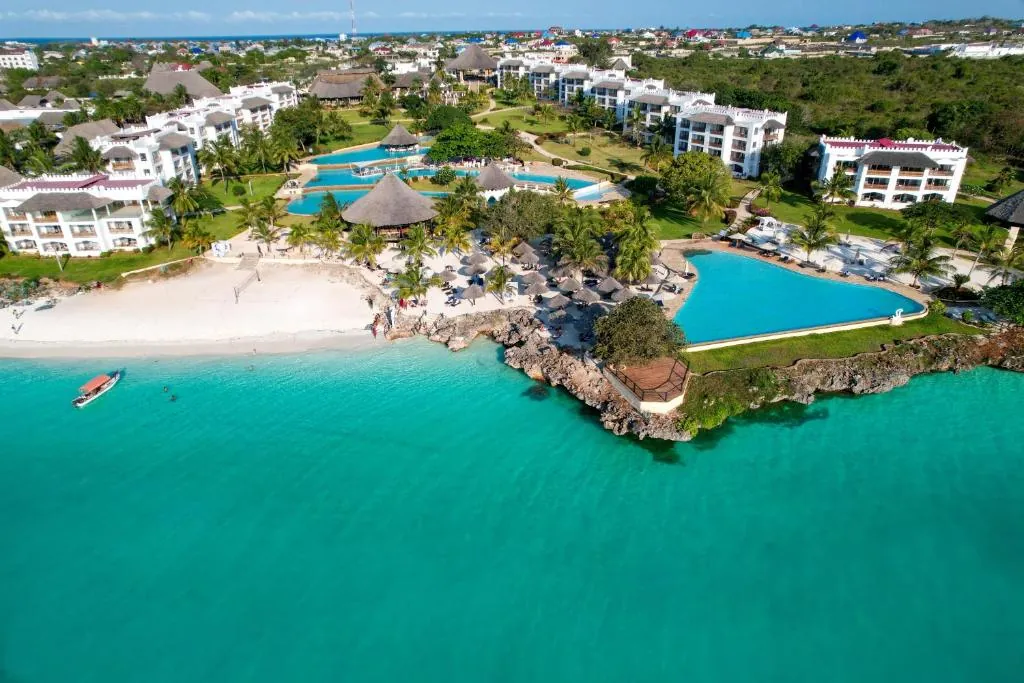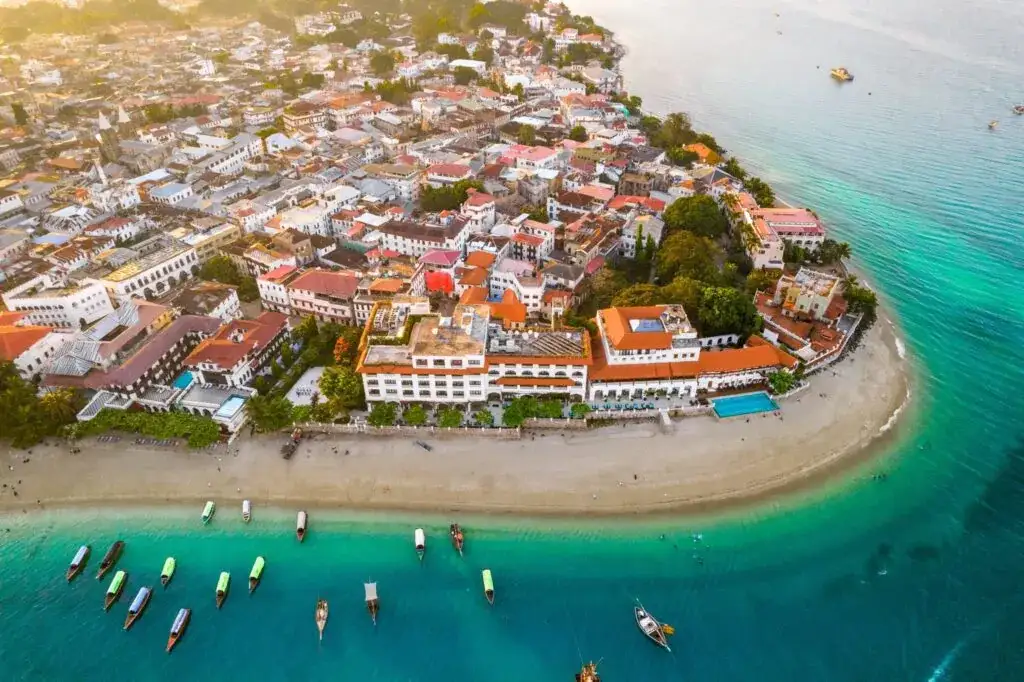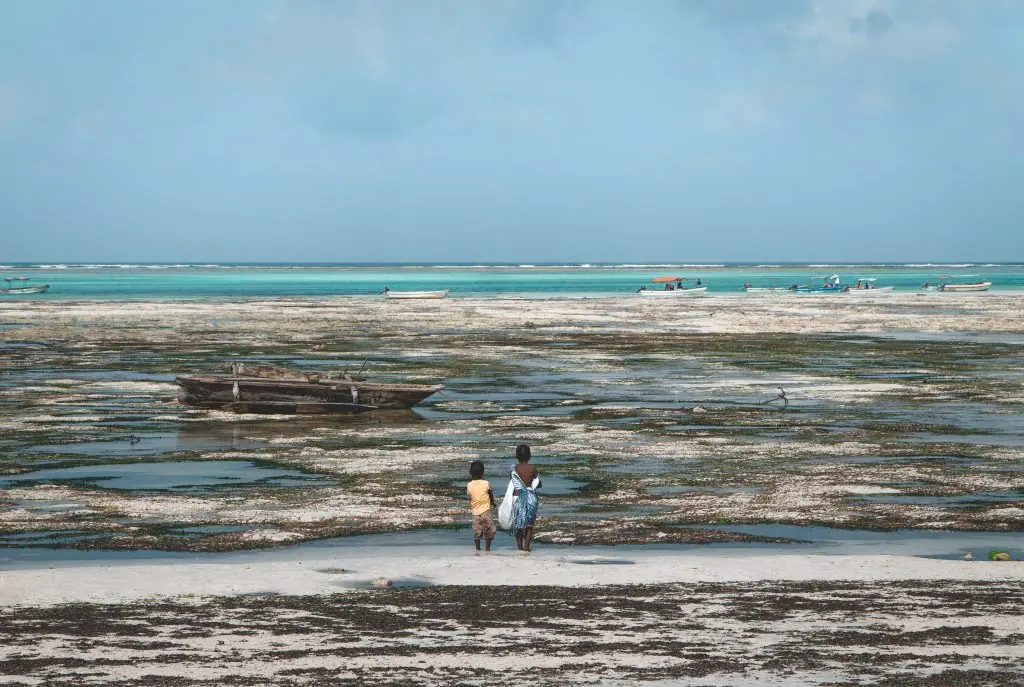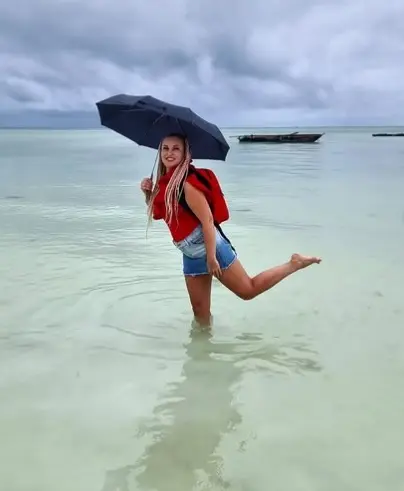Beaches & Destinations • 2025 Edition
Kendwa, Nungwi, Matemwe, Paje, Jambiani, Bwejuu, Kizimkazi — every stretch of sand tells its own story. This page pulls everything together: which coast suits what mood, what tides really mean, where to swim all day, where to find nightlife, where to disappear off the grid. If you want the long version — the real version — keep scrolling.

The north of Zanzibar pulls people the way a fire pulls moths. Kendwa and Nungwi live at the tip of the island, where the water keeps its nerve even when the tide shifts elsewhere. You can swim morning to night without that long walk over wet sand, and that reliability changes the whole mood. It’s why families book the north without knowing the science of tides, and why first‑timers land here and think, this is what I imagined, this exact blue, this exact calm.
Kendwa is the easy postcard. Wide beach, powdered sand, big sky sunsets that drop like a curtain. It’s quieter than Nungwi yet not shy. You can stroll at 5pm and see dhow crews rigging sails, joggers weaving around sandcastles, and honeymooners trying to time a kiss with the sun. The parties come and go with the moon; you can avoid them or lean in. The choice is the point.
Nungwi is louder, a messy collage. Fishing boats run right onto the beach. In the morning there’s bargaining over tuna, snapper, sometimes marlin, while a dive instructor ties tanks in the shade. Backpacker bars hum beside luxury rooftops. You sip coconut water and hear three songs at once from three speakers and somehow it works. Nungwi is friction and fizz.
Swimming up here is simple. No seaweed farms underfoot, no one‑kilometer walkouts, no guessing games with the ocean’s timetable. If you’ve only got a short stay and you want guaranteed swims, northern beaches are your safest bet. The trade‑off is that prices bite harder in school holidays, but you buy ease, and ease is expensive.
A day in the north runs on sunlight. Breakfast slips into late morning; someone always orders one more mango juice. By afternoon you’re floating, then drifting, then asleep under a hat. Late day brings the crowd: locals in football shirts, kids body‑surfing near the shallows, a fruit seller balancing pineapples like a crown. Sunset is ceremony. You feel the island slow down and pay attention.
Common mistakes up here? People over‑plan. They stack activities hour to hour, then wonder why the best moments were the unscripted ones. Another mistake: assuming every expensive hotel hugs a perfect swimming stretch. Walk the beach yourself before you commit. And the classic error: forgetting the village behind the resorts. Nungwi isn’t only a beach; it’s a place with fishermen, tailors, mechanics, kids racing homemade kites. Step off the sand and buy a soda in a side street. You’ll remember that more than the pool.
Spend two days in the north coast (Kendwa and Nungwi) and you’ll think you know it. Spend seven and it will politely prove you wrong. Let the north coast (Kendwa and Nungwi) change your schedule instead of asking it to obey yours. In the north coast (Kendwa and Nungwi) nobody is in a hurry until suddenly everyone is, usually at sunset when the light turns expensive. The worst mistake in the north coast (Kendwa and Nungwi) is to line up activities like a spreadsheet and then wonder where the wonder went. Vendors in the north coast (Kendwa and Nungwi) remember your face quicker than your name and will call you ‘rafiki’ even when you bargain badly. People carry stories across the north coast (Kendwa and Nungwi) the way dhows carry shadows across the bay. Morning smells different in the north coast (Kendwa and Nungwi): wood smoke and bread and the clean mineral scent of the tide turning. Ask three locals about the north coast (Kendwa and Nungwi) and you’ll get five opinions. the north coast (Kendwa and Nungwi) looks different depending on the hour you arrive. Maps flatten the north coast (Kendwa and Nungwi), but your feet don’t — they learn the slants, the shortcuts, the soft sand that traps the careless. You notice small things in the north coast (Kendwa and Nungwi): the squeak of flip‑flops, a kite line humming, a radio playing taarab next door. The best advice for the north coast (Kendwa and Nungwi) is to walk without headphones and let the place talk first.

The east coast is a different tempo. Paje, Jambiani, and Bwejuu live by the clockwork of tides. At low tide the sea retreats and reveals a second world: seaweed gardens, sand ribs, bright starfish, boats tilting on their bellies like sleeping animals. Hours later everything is ocean again, flat and fast, kite lines drawing bright geometry across the sky. Some travelers call it inconvenient; others fall in love with the mood swing.
Paje is the nerve center. Kitesurf schools line the beach like surf shacks in a movie. There are beanbags, juice bars, barefoot cafés, young crowds mixing with travelers who came for a week and stayed a season. Nightlife is not clubs as much as bonfires and beats in the sand. Wake early and the same beach holds fishermen wading home with octopus in hand, and a woman laughing as a wave nips her ankles. Paje is many realities layered on top of each other.
Jambiani is slower and older. Village life doesn’t hide here; it lives right on the path to the sea. You’ll pass a woman weaving a mat, a grandfather fixing a bicycle with two tools and a prayer, kids practicing a dance routine on the way to school. Hotels stay small on purpose. Conversations are long. Tea is sweet. People wave. It’s hard to leave.
Bwejuu whispers instead of shouts. Guests read under palms. Couples share quiet, not content. If you want retreat but like the idea of borrowing Paje’s energy for a night out, Bwejuu keeps that balance. The tide draws lacework on the shore and the afternoons feel stretched thin and silk‑soft.
Mistakes on the east? People forget to check tide charts and then complain that the sea ‘vanished.’ It didn’t vanish; it’s teaching you patience. Plan snorkels and swims for the right windows. Wear sandals for the tide‑pool walks. And learn a few Swahili hellos; it changes every interaction.
Spend two days in the east coast (Paje, Jambiani, Bwejuu) and you’ll think you know it. Spend seven and it will politely prove you wrong. People carry stories across the east coast (Paje, Jambiani, Bwejuu) the way dhows carry shadows across the bay. You notice small things in the east coast (Paje, Jambiani, Bwejuu): the squeak of flip‑flops, a kite line humming, a radio playing taarab next door. The best advice for the east coast (Paje, Jambiani, Bwejuu) is to walk without headphones and let the place talk first. Let the east coast (Paje, Jambiani, Bwejuu) change your schedule instead of asking it to obey yours. Morning smells different in the east coast (Paje, Jambiani, Bwejuu): wood smoke and bread and the clean mineral scent of the tide turning. The worst mistake in the east coast (Paje, Jambiani, Bwejuu) is to line up activities like a spreadsheet and then wonder where the wonder went. Maps flatten the east coast (Paje, Jambiani, Bwejuu), but your feet don’t — they learn the slants, the shortcuts, the soft sand that traps the careless. Ask three locals about the east coast (Paje, Jambiani, Bwejuu) and you’ll get five opinions. the east coast (Paje, Jambiani, Bwejuu) looks different depending on the hour you arrive. In the east coast (Paje, Jambiani, Bwejuu) nobody is in a hurry until suddenly everyone is, usually at sunset when the light turns expensive. Vendors in the east coast (Paje, Jambiani, Bwejuu) remember your face quicker than your name and will call you ‘rafiki’ even when you bargain badly.

Matemwe is for people who like silence that isn’t empty. Long beach, low hotels, thoughtful kitchens, and that line on the horizon: Mnemba. The reef is the pilgrimage. At dinner the divers can’t stop talking — turtles sliding past, whole walls of fish flashing, the sunlight cutting down like ladders through the water. The snorkelers drift back to shore grinning, skin warm, salt drying in the corners of their eyes.
Everything in Matemwe is unhurried. Breakfasts drift into noon. Pools look like they were poured out of the sky. Staff learn your rhythm on day two and anticipate it on day three. A lot of honeymooners land here because they want privacy without isolation. A lot of repeat travelers return because they finally figured out what vacation pace works for them, and it wasn’t a race.
If Kendwa is the extrovert and Paje is the creative, Matemwe is the listener. You speak less here. You notice more — how the wind changes at 4pm, how the reef boats leave in clusters, how the night is full of tiny sounds when you switch off your phone.
The worst mistake in Matemwe and Mnemba is to line up activities like a spreadsheet and then wonder where the wonder went. You notice small things in Matemwe and Mnemba: the squeak of flip‑flops, a kite line humming, a radio playing taarab next door. The best advice for Matemwe and Mnemba is to walk without headphones and let the place talk first. Spend two days in Matemwe and Mnemba and you’ll think you know it. Spend seven and it will politely prove you wrong. Vendors in Matemwe and Mnemba remember your face quicker than your name and will call you ‘rafiki’ even when you bargain badly. Maps flatten Matemwe and Mnemba, but your feet don’t — they learn the slants, the shortcuts, the soft sand that traps the careless. People carry stories across Matemwe and Mnemba the way dhows carry shadows across the bay. Let Matemwe and Mnemba change your schedule instead of asking it to obey yours. In Matemwe and Mnemba nobody is in a hurry until suddenly everyone is, usually at sunset when the light turns expensive. Ask three locals about Matemwe and Mnemba and you’ll get five opinions.

Kizimkazi sits on edges and cliffs. People know it for dolphins, and that’s a story with chapters: some operators are careful, some aren’t, and travelers have to choose. But if you zoom out, the south is about quiet villages, mosques calling across the water at sunset, fishermen drawn small against a big, deep sea. It’s less about beach spreads and more about viewpoints.
You’ll find guesthouses high on rock ledges and paths that drop to pocket beaches. Restaurants built into the cliff with candles flickering in salt air. Night feels close here. Stars press down. You hear conversations carry a long way and then disappear as if the ocean swallowed the words.
Ask three locals about Kizimkazi and the south and you’ll get five opinions. The best advice for Kizimkazi and the south is to walk without headphones and let the place talk first. In Kizimkazi and the south nobody is in a hurry until suddenly everyone is, usually at sunset when the light turns expensive. Spend two days in Kizimkazi and the south and you’ll think you know it. Spend seven and it will politely prove you wrong. Let Kizimkazi and the south change your schedule instead of asking it to obey yours. Kizimkazi and the south looks different depending on the hour you arrive. Morning smells different in Kizimkazi and the south: wood smoke and bread and the clean mineral scent of the tide turning. The worst mistake in Kizimkazi and the south is to line up activities like a spreadsheet and then wonder where the wonder went.

Stone Town isn’t a swimming beach, but it belongs on a beach page because the waterfront is the island’s front porch. Ferries roll in. Kids dive from the seawall. Dhow captains tell old jokes while mending sails. At sunset Forodhani lights up: octopus skewers hissing, sugarcane pressed into glass, the so‑called Zanzibar pizza flipping like a magic trick. You come here to remember that the sea isn’t scenery. It’s livelihood and rhythm.
Let Stone Town’s waterfront change your schedule instead of asking it to obey yours. Vendors in Stone Town’s waterfront remember your face quicker than your name and will call you ‘rafiki’ even when you bargain badly. You notice small things in Stone Town’s waterfront: the squeak of flip‑flops, a kite line humming, a radio playing taarab next door. Spend two days in Stone Town’s waterfront and you’ll think you know it. Spend seven and it will politely prove you wrong. Maps flatten Stone Town’s waterfront, but your feet don’t — they learn the slants, the shortcuts, the soft sand that traps the careless. People carry stories across Stone Town’s waterfront the way dhows carry shadows across the bay. Stone Town’s waterfront looks different depending on the hour you arrive. The best advice for Stone Town’s waterfront is to walk without headphones and let the place talk first.

Tides decide more on this island than any brochure will admit. North: gentle swings, nearly always swimmable. East and southeast: theater. Water leaves, water returns, beach becomes moon, then sea again. If you treat tides like a schedule — your schedule — they’ll annoy you. If you treat them like a whisper — their whisper — they’ll give you secret hours you’d never plan for.
Families who want zero guesswork should choose Kendwa or Nungwi. If you’ve got little ones, short legs, or naps to coordinate, predictability is mercy. If your kids are explorers and you like turning nature into a lesson, then Paje or Jambiani at low tide becomes the best classroom you ever had. Count starfish. Track hermit crabs. Watch seaweed farmers tend lines that become lunch.
Let the tides change your schedule instead of asking it to obey yours. the tides looks different depending on the hour you arrive. Ask three locals about the tides and you’ll get five opinions. You notice small things in the tides: the squeak of flip‑flops, a kite line humming, a radio playing taarab next door. Morning smells different in the tides: wood smoke and bread and the clean mineral scent of the tide turning. People carry stories across the tides the way dhows carry shadows across the bay. In the tides nobody is in a hurry until suddenly everyone is, usually at sunset when the light turns expensive. The best advice for the tides is to walk without headphones and let the place talk first.
Beach food isn’t just the resort menu. It’s snacks carried on heads, it’s smoke drifting from a grill in the lane behind your hotel, it’s fruit hacked open with a machete that looks older than the seller. You eat on the beach because everything tastes better with salt air.
What you’ll probably eat, even if you didn’t plan to: Coconut bread from a lady who knows your face by day three and teases you for always asking for the end piece. Octopus grilled over charcoal, brushed with a sauce someone’s uncle swears he invented, served on paper that struggles against the wind. Chapati torn by hand and shared, the way good bread should be, with laughter and too much tea. Mishkaki skewers that cost less than a bottled water yet somehow taste like a celebration. Mangoes that ruin you for mangoes back home. Pineapples that make you suspicious of every pineapple you ate before.
Eat with your hands sometimes. Sit on a low wall. Share something with a stranger. Leave a tip that feels good, not showy. Remember that recipes here are not written; they’re told. If you ask for measurements, someone will point at a grandmother’s palm.

Seasons shape the colors of this island. June to October: clear air, mild heat, long visibility in the water. December holidays: bright, busy, prices creeping up with every sunset. March and November: shoulder months with fewer crowds and softer light. April–May: long rains that wash dust from leaves and send most tourists home; some travelers quietly love it.
Wind matters to kiters, visibility matters to divers, and price matters to the rest of us. If you want the cleanest air and the slightest chance of goosebumps in the evening, that June–October window is gold. Festive season brings spark and crowds and the kind of prices that make you say a quiet prayer at checkout. Shoulders are kind: you get space, decent rates, and light that flatters every photo without trying.
There are rain days that make reading under a roof feel like an event. There are wind days that slap the sea into texture. There are still days when the ocean acts like a mirror and every cloud falls in love with itself. If you chase perfection, you might miss the charm.
Not all travelers want the same beach, thank goodness. The trick is to match your mood to a shoreline.
The First‑Timer: Wants the swim‑whenever promise and photos that look like the brochure. North coast fits the bill. Choose a base that matches your habits, not a stranger’s Instagram.
The Honey‑Month Couple: Privacy without boredom. Matemwe or Bwejuu in a small property where they learn your breakfast order. Choose a base that matches your habits, not a stranger’s Instagram.
The Kites‑And‑Coffee Creative: Paje all day. Board, laptop, barefoot meetings that drift into sunset. Choose a base that matches your habits, not a stranger’s Instagram.
The Family Herd: Kendwa/Nungwi for predictability, big pools, kids’ menus, and the ability to bail on a plan without losing the day. Choose a base that matches your habits, not a stranger’s Instagram.
The Quiet Repeat Visitor: Matemwe or Pongwe. Long walks, few people, a good book, better sleep. Choose a base that matches your habits, not a stranger’s Instagram.
The Night Owl: Nungwi for clubs or Paje for bonfires. Dawn swims are optional. Choose a base that matches your habits, not a stranger’s Instagram.
If you’re a mixed group, split the stay: culture in Stone Town first, then the coast that suits the majority. Or go north for the swim‑whenever freedom and finish with a hush in Matemwe so everyone flies home calm.
Which beach has the best sunsets? North coast — Kendwa and Nungwi, where the sky performs and no building dares interrupt the horizon.
Where’s nightlife? Nungwi if you want clubs, Paje if you prefer a bonfire and a DJ who reads the vibe instead of a playlist.
Best for kids? Kendwa. Shallow entries, predictable swims, and hotels that understand early dinners.
Best snorkeling? Mnemba by boat; off‑beach options vary with tide and wind. Don’t be stubborn — pick the right day, not the exact date on your calendar.
Is the sea dangerous? Respect it like you’d respect a wise elder. Ask locals, watch flags, listen for changes. Danger mostly visits the careless.
You don’t need a flawless plan. You need a good match: the right coast for the way you actually live. Tell us your dates, your group size, and the mood you want — energetic, quiet, social, secret — and we’ll shape a stay that keeps the best parts simple: swims at the right hour, dinners that feel like rituals, transfers that don’t steal your day.
When you’re ready, say hello on WhatsApp. We’ll ask a few questions you won’t find on a booking engine, then give you two or three clear choices and the plain‑English trade‑offs. That’s it.